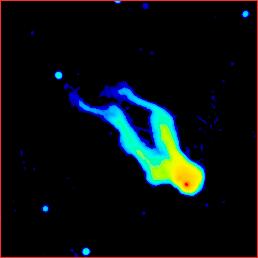 Image:
Image:
Identified with NGC 3862, the largest elliptical galaxy in Abell 1367.
This is a classic "unrelaxed" cluster of galaxies (e.g.
Lazzati et al. 1998),
and NGC 3862 is well offset from the cluster centre, which is
over a hundred kpc to the NW. Richard White's set of cluster "mug shots"
includes
optical and X-ray images of A 1367.
The large scale radio structure
is usually classified as a peculiar kind of twin tail; unusual because the
two tails are not exactly parallel and also because of the diffuse "halo"
surrounding the bright compact core. At high resolution a short,
bright, one-sided radio and optical jet (Baum
et al. 1997) extends from
the core towards the NE. At intermediate resolution the jet bends and becomes
much fainter but can be traced into a weak hotspot
(Lara et al. 1997).
This hotspot appears in our image as a barely visible peak just to the NE
of the core. Lara et al's image also shows a weak feature to the SW, which
may be the other hotspot. It is not clear which hotspot feeds which
tail. The core is also bright in X-rays (e.g.
Edge & Rottgering 1995).
The jet is presumably one-sided because of relativistic beaming, which
suggests that the blob-like appearance of the central region may be enhanced
because our line of sight is fairly close to the jet axis, causing significant
forshortening. If so, the large-scale structure might better be explained
as a "wide-angle tail" (c.f. 3C 465)
seen close to the plane of the tails.
Page created: 2009 Apr 2 14:16:43
J. P. Leahy
jpl@jb.man.ac.uk
 Image:
Image: